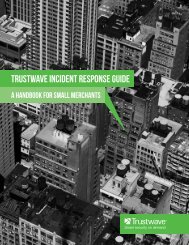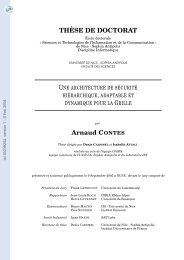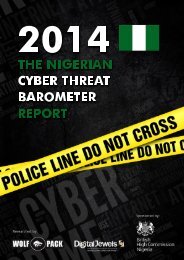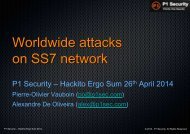JWP-Binde-McRee-OConnor
JWP-Binde-McRee-OConnor
JWP-Binde-McRee-OConnor
You also want an ePaper? Increase the reach of your titles
YUMPU automatically turns print PDFs into web optimized ePapers that Google loves.
Assessing Outbound Traffic to Uncover Advanced Persistent Threat<br />
● OSSEC is a host-based open source IDS, as opposed to Snort. Its correlation and<br />
analysis engine provides log analysis, file integrity checking, Windows registry<br />
monitoring, rootkit detection, and time-based alerting as well as active response and can<br />
support most operating systems. [TrendMicro, 2011]<br />
● Splunk is a search, monitoring and reporting tool integrating logs and other data from<br />
applications, servers and network devices. The data repository is indexed and can be<br />
queried to create graphs, reports and alerts. [Splunk.com, 2011]<br />
● Sguil includes an intuitive GUI that provides access to realtime events, session data, and<br />
raw packet captures. Sguil facilitates the practice of network security monitoring and<br />
event driven analysis. [Visscher, 2008]<br />
● Squert is a web application used to query and view event data stored in a Sguil<br />
database. Through the use of metadata, time series representations, weighted and<br />
logically grouped result sets it provides additional context to events. [Squert<br />
contributors, 2011]<br />
● ModSecurity is a firewall for web applications.[Trustwave, 2010]<br />
The tools fit into the general category of network security monitoring (NSM), as described in<br />
several books by Richard Bejtlich. [Bejtlich 2005, 2010, 2011] The challenge is to identify new<br />
APT attacks (and variants of previous attacks). The goal is to propose methodology for the<br />
detection of APT.<br />
Rule Sets<br />
There are several methods for the possible detection and prevention of APT-like attacks using<br />
rule sets or signatures. Commonly used in Intrusion Detection Systems (IDS), signatures match<br />
known malicious patterns of system and network behavior. As they relate specifically to the<br />
RSA attack, these include:<br />
●<br />
●<br />
●<br />
identification of phishing campaigns<br />
recognize and block malicious traffic such as that associated with PI-RAT (Snort)<br />
monitor the Windows registry for ―known bad‖ entries (OSSEC)<br />
The RSA breach started with a phishing campaign. The Sourcefire Vulnerability Research<br />
Team (VRT) maintains a set of rules to identify and block phishing campaigns. This rule base<br />
(phishing-spam.rules) can be downloaded from the VRT Certified Rule Packages site and<br />
should be enabled in blocking mode. [Sourcefire Vulnerability Research Team, 2011]<br />
Page 9










